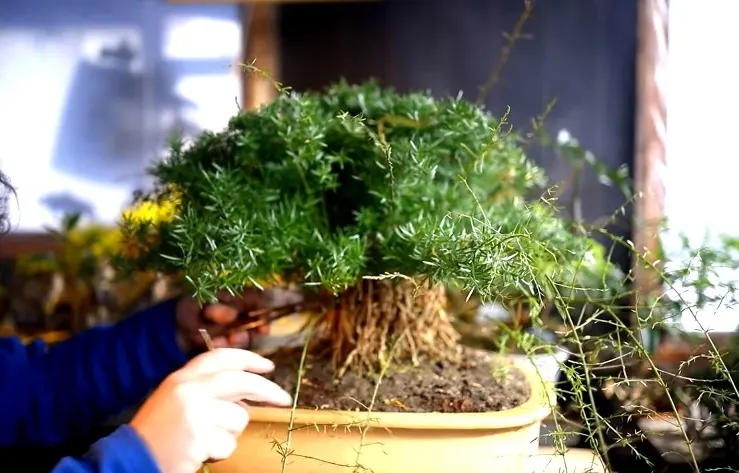Welcome to our expert guide to achieving healthy, lush asparagus ferns through proper pruning. Asparagus ferns are a popular houseplant known for their delicate foliage and trailing vines. However, without the right care and maintenance, these plants can quickly become overgrown and lose their characteristic lushness.
That’s where pruning comes in. Regular pruning is essential for maintaining the health and appearance of asparagus ferns. In this guide, we’ll walk you through everything you need to know about asparagus fern pruning, from when to prune to best practices and common mistakes to avoid.
Key Takeaways:
- Pruning is essential for maintaining healthy and lush asparagus ferns.
- Knowing when and how to prune is key to success.
- Post-pruning care is important for supporting healthy regrowth.
- Avoid common mistakes and troubleshoot potential challenges for optimum results.
Understanding Asparagus Ferns: A Brief Overview
In this section, we will provide a brief overview of asparagus ferns, including their characteristics, growth habits, and common care requirements. This information will help readers understand the specific needs of asparagus ferns when it comes to pruning.
The asparagus fern, also known as Asparagus aethiopicus, is a popular houseplant that is native to South Africa. Despite its name, it is not a true fern, but rather a member of the lily family. Asparagus ferns are known for their delicate, feathery foliage and soft, spiky stems. They can grow up to three feet tall and two feet wide, making them a great choice for filling empty spaces in your home.
Asparagus ferns are relatively low maintenance and can thrive in a variety of environments. They prefer bright, indirect light and well-draining soil. They can tolerate a wide range of temperatures, but prefer a warm and humid environment. Asparagus ferns are also known for their ability to grow quickly and can become invasive if left unchecked.
When it comes to pruning, asparagus ferns require regular attention to maintain their health and appearance. This includes removing dead or yellowing fronds, cutting back overgrown stems, and shaping the plant to promote bushy growth. Proper pruning techniques are essential for ensuring the continued growth and vitality of your asparagus ferns.

When to Prune Asparagus Ferns: Timing Is Key
Knowing when to prune your asparagus fern is essential to maintaining its health and appearance. Pruning at the right time can help promote bushier growth and prevent the plant from becoming too leggy and overgrown.
The best time to prune your asparagus fern is in the spring or early summer when new growth appears. This is when the plant is actively growing, and pruning can stimulate new growth and improve its overall appearance. Wait until the plant has at least a few inches of new growth before pruning.
You may also need to prune your asparagus fern throughout the year to remove dead or yellowing fronds or to keep the plant at a manageable size. Additionally, you can prune the plant after it has finished flowering in the fall to tidy it up and remove any dead or damaged fronds.
It’s important to avoid pruning your asparagus fern during the winter when it goes dormant. Pruning during this time can slow down or even stunt the plant’s growth, and it may not recover until the following growing season.
When pruning your asparagus fern, pay attention to signs that indicate the need for trimming. If the plant becomes too tall, spindly, or top-heavy, it’s probably time to prune it down to size. Similarly, if the fronds start to droop or wilt, they may be too heavy for the plant to support, and pruning can help it recover.
By pruning your asparagus fern at the right time, you can ensure that it thrives and remains healthy year after year. Remember to wait until the plant has new growth in the spring or early summer before pruning, and avoid trimming during the winter dormancy period.
Step-by-Step Guide: How to Prune Asparagus Ferns
Pruning asparagus ferns can be intimidating, especially if you’ve never done it before. However, with the right tools and techniques, it’s a straightforward process that can significantly benefit your plants. Here’s a step-by-step guide to help you prune your asparagus ferns like a pro:
- Prepare your tools: You’ll need pruning shears, gardening gloves, and a container for the cuttings.
- Choose the right stems to prune: Look for yellowing or brown stems or stems that are growing too tall or out of shape. These stems are likely to be weaker and less productive, so they’re good candidates for removal.
- Cut the stems: Using your pruning shears, make a clean cut near the base of the stem, about an inch or two above the soil line. Avoid cutting into the woody stems, as this can damage the plant’s structure.
- Dispose of the cuttings: Place the cuttings into your container for disposal or composting. Be sure to wear gloves to avoid contact with the plant’s sap, which can cause skin irritation.
- Water and feed: After pruning, give your asparagus fern a thorough watering and a dose of fertilizer. This will help stimulate new growth and ensure the plant remains healthy.
Remember to take it slow and steady when pruning your asparagus ferns. It’s better to remove too little than too much, and you can always prune more later if needed. By following these simple steps, you can keep your asparagus ferns looking healthy and vibrant year-round.
Pruning Tips for Healthy Asparagus Ferns
Proper pruning is an essential aspect of asparagus fern care that ensures healthy, bushy growth. Here are some expert tips for pruning asparagus ferns:
1. Use the Right Tools
Ensure you use clean, sharp pruning shears to avoid crushing the plant’s stems and causing damage. Dull blades can end up tearing the plant tissue, which can lead to an unsightly appearance and make it more susceptible to diseases.
2. Prune Only Healthy Stems
Prune only healthy stems and avoid cutting into the woody part of the plant. Cut only the thin, wispy stems at their base, leaving the thicker, more mature stems untouched. This ensures that the plant has enough energy to grow and supports new growth.
3. Don’t Overdo It
Pruning should not cause the plant to look sparse or bare. Be mindful of the amount of foliage you remove, and avoid over-pruning. Typically, pruning one-third of the plant is a safe measure.
4. Watch for Signs of Unhealthy Growth
If your asparagus fern is showing signs of yellowing, wilting, or rotting stems, it may be time for pruning. Removing the dead or diseased stems can prevent the spread of diseases and encourage healthy growth.
5. Remove Old Foliage
Asparagus ferns tend to accumulate dead foliage and debris, which can lead to pest infestations and diseases. Gently remove the dead foliage using your fingers or a soft brush to avoid damaging the healthy foliage.
By following these tips, you can be sure to maintain healthy, lush asparagus ferns for your home or garden.
[youtube width=630 height=350]xsimjFjmXhk[/youtube]
Maintaining Lush Asparagus Ferns: Post-Pruning Care
After pruning your asparagus fern, it’s important to provide the right care to promote healthy regrowth and ensure the continued vibrancy of your plant. Here are some tips to help you maintain your asparagus fern’s lush appearance:
- Watering: Keep the soil moist, but not waterlogged, by watering your fern regularly.
- Fertilizing: Apply a balanced, water-soluble fertilizer every four to six weeks during the growing season to encourage healthy growth.
- Light: Asparagus ferns thrive in bright, indirect light. Avoid exposing them to direct sunlight, which can scorch their foliage.
- Temperature: Keep your fern in a room with temperatures between 60 and 75 degrees Fahrenheit. Avoid placing them near drafts or vents that can cause temperature fluctuations.
- Humidity: Asparagus ferns prefer high humidity levels. You can increase the humidity around your plant by misting it with water or placing a tray of water nearby.
- Repotting: If your asparagus fern has outgrown its current container, repot it in a slightly larger pot with fresh, well-draining soil.
“By following these post-pruning care tips, your asparagus fern will have the best chance of regaining its lush appearance and thriving for years to come.”
Common Mistakes to Avoid When Pruning Asparagus Ferns
Pruning asparagus ferns might seem like a straightforward task, but it’s easy to make mistakes that can damage the plant or compromise its health. Here are some common mistakes to avoid when pruning your asparagus fern:
- Pruning too much: Asparagus ferns can be pruned heavily, but it’s essential to avoid cutting back more than one-third of the plant at a time. Removing too many fronds can shock the plant and even kill it.
- Cutting the wrong fronds: It’s crucial to prune the right fronds to promote healthy growth. Avoid cutting new, green fronds at the center of the plant, as they are the source of growth. Focus on removing yellowed or brown fronds instead.
- Using dull or dirty tools: Using blunt or dirty tools can damage the plant and introduce disease. Make sure to use clean, sharp pruning shears to make clean cuts.
- Not sterilizing tools between cuts: Asparagus ferns are susceptible to disease, so it’s essential to clean and sterilize tools between cuts. Use rubbing alcohol or bleach to disinfect your pruning shears before making the next cut.
- Ignoring signs of pests or diseases: Pests and diseases can quickly spread and cause significant damage to asparagus ferns. Keep an eye out for any signs of infestations, such as discoloration or damage to the leaves, and take action to address the issue before pruning.
- Pruning at the wrong time: Pruning at the wrong time can be detrimental to plant health. Avoid pruning during the winter months or during periods of stress, such as drought or extreme heat.
Remember, proper pruning is essential for maintaining healthy asparagus ferns. Avoid these common mistakes to ensure your plant thrives.
Troubleshooting: Dealing with Pruning Challenges
While pruning asparagus ferns may seem like a straightforward process, challenges can arise. Here are some potential issues you may encounter and how to overcome them.
Leaf Discoloration
If you notice brown or yellow patches on the leaves after pruning, it may be a sign of sunburn or over-fertilization. This can happen when the plant is exposed to direct sunlight or receives too much fertilizer. To address this issue, move the plant to a shadier area and avoid fertilizing for a few weeks.
Slow Growth
If your asparagus fern seems to be growing slowly after pruning, it may be a sign of underwatering or lack of nutrients. Check the soil moisture and ensure the plant is receiving adequate water. You may also want to fertilize the plant with a balanced, all-purpose fertilizer.
Wilting
If your asparagus fern is wilting after pruning, it may be due to shock or root damage. This can happen if you prune too much or accidentally damage the roots during the process. To address this issue, water the plant thoroughly and move it to a shadier area to help it recover.
By following our expert guide to pruning asparagus ferns and avoiding common mistakes, you can ensure the continued health and growth of your plants. And, should any challenges arise, these troubleshooting tips will help you overcome them with ease.
Conclusion: Prune for Success with Asparagus Ferns
Asparagus ferns are a popular choice for indoor and outdoor plants, thanks to their delicate, yet lush appearance. However, proper care and maintenance, including pruning, are vital for ensuring healthy growth and improved plant health. In this expert guide, we have covered the best practices for asparagus fern pruning to help you achieve the lush, vibrant plant you desire.
Remember, timing is key when it comes to pruning asparagus ferns. Waiting until the plant is overgrown or damaged can lead to stunted growth and poor health. Instead, aim to prune regularly, especially during the plant’s growing season.
Practical Tips for Pruning Asparagus Ferns
When pruning asparagus ferns, it’s essential to use proper techniques and equipment. Start by removing dead or damaged fronds and stems, then trim back any overgrown areas. Be careful not to damage healthy parts of the plant in the process. Remember to sanitize your tools before and after pruning to avoid the spread of disease.
Following pruning, remember to provide optimal growing conditions, including adequate water, light, and humidity. Overwatering or underwatering can be detrimental to the plant’s health, so be sure to monitor its moisture levels carefully.
Avoid Common Mistakes for Successful Pruning
When pruning asparagus ferns, it’s easy to make common mistakes that can compromise the plant’s health. For example, avoid pruning too much at once, as this can lead to shock and stunted growth. Additionally, avoid cutting back too close to the base of the plant, as this can damage or kill it.
Dealing with Pruning Challenges
If you’re experiencing challenges with pruning your asparagus ferns, don’t panic. Leaf discoloration, slow growth, or wilting are common issues that can be addressed with proper care and attention. Consider adjusting the plant’s growing conditions, such as improving lighting or adjusting watering levels.
In conclusion, pruning asparagus ferns is an essential part of their care and maintenance. By following the expert tips and best practices provided in this guide, you can achieve healthy, lush plants that will enhance your indoor or outdoor space. Happy pruning!
FAQ
Q: Why is pruning important for asparagus ferns?
A: Pruning is important for asparagus ferns as it helps maintain their overall health and appearance. Removing dead or yellowing foliage promotes new growth and prevents the spread of diseases or pests. Pruning also helps shape the plant and encourages bushier growth.
Q: How often should I prune my asparagus fern?
A: Asparagus ferns should be pruned regularly to maintain their health and appearance. It is recommended to prune them every 2-3 months or as needed, depending on the growth rate and condition of the plant.
Q: What tools do I need for pruning asparagus ferns?
A: To prune asparagus ferns, you will need a clean pair of pruning shears or scissors. Make sure the tools are sharp to ensure clean cuts and minimize damage to the plant.
Q: Can I prune my asparagus fern at any time of the year?
A: While asparagus ferns can be pruned throughout the year, it is best to do so during their active growing season, which is typically in spring and summer. Pruning during this time gives the plant ample time to recover and regrow new foliage.
Q: How much should I prune off my asparagus fern at a time?
A: When pruning asparagus ferns, it is recommended to remove no more than one-third of the plant’s foliage at a time. This ensures that the plant can recover and continue to grow healthily.
Q: What should I do with the pruned foliage?
A: The pruned foliage can be discarded in compost or thrown away. Avoid leaving the pruned foliage around the plant, as it can attract pests or promote the spread of diseases.
Q: How can I prevent my asparagus fern from becoming overgrown?
A: Regular pruning is key to prevent asparagus ferns from becoming overgrown. By removing excessive foliage and maintaining a compact shape, you can control the plant’s size and promote healthier growth.
Q: Can I propagate my asparagus fern from the pruned cuttings?
A: Yes, you can propagate asparagus ferns from the pruned cuttings. Simply place the cuttings in a jar of water or a well-draining potting mix, ensuring that at least one node is submerged or inserted into the soil. After a few weeks, roots should start to develop, and you can transfer the cuttings to their own pots.












